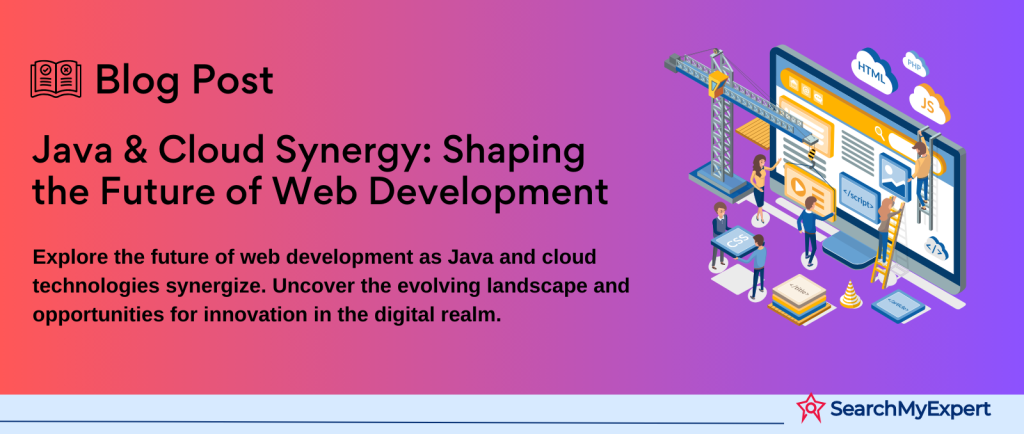Java and Cloud Integration in Web Development
Java: The Backbone of Web Development
Java stands as a titan in the world of web development. Why? Here’s the scoop:
- Ubiquity: Java
is everywhere! From corporate giants to startups, it’s the go-to language. - Platform Independence:
Write once, run anywhere – that’s Java’s motto. This means code written on one platform runs seamlessly on others. - Robust and Reliable:
Java’s maturity isn’t just about age. It’s battle-tested, and proven in the most demanding environments. - Rich Ecosystem: Libraries, frameworks, tools – Java’s got them all. This ecosystem simplifies and speeds up development.
Cloud Computing: Revolutionizing Web Development
Enter cloud computing – the game-changer. What’s the buzz about?
- Scalability:
Need more resources? Cloud’s got your back. Scale up or down effortlessly. - Cost-Effectiveness: Pay for what you use. This means big savings, especially for smaller projects.
- Agility:
Quick deployments, updates, and changes are the norm with cloud computing.
The Perfect Pair: Java and Cloud Integration
When Java meets the cloud, magic happens in web development. Here’s why:
- Seamless Integration: Java’s flexibility makes it a natural fit for cloud environments.
- Enhanced Performance:
Java’s speed and cloud computing’s power creates a robust platform. - Economic and Efficient: This combo means more bang for your buck – efficient development with reduced costs.
Advantages of Java and Cloud Integration
Scalability: Handling the Ups and Downs with Ease
- Elasticity: Java and cloud combo adapts to traffic spikes and dips effortlessly.
- Resource Management:
Optimize resource usage based on demand.
Cost-Effectiveness: Smart Spending with Pay-As-You-Go
- No Upfront Costs: Forget heavy initial investments; pay for what you need, when you need it.
- Budget-Friendly: Ideal for businesses of all sizes, especially startups.
Performance: Supercharging Web Applications
- Speedy Loading:
Cloud infrastructure turbocharges Java applications, reducing load times. - Enhanced Responsiveness:
Improved user experience with snappier application responses.
Agility: Quick on the Feet
- Fast Deployment:
Launch updates and new features in a snap. - Accelerated Development:
Shorter development cycles, more time innovating.
Security: Fort Knox in the Cloud
- Top-Notch Security Features: Robust protections from cloud providers.
- Data Protection: Safeguarding user data, and maintaining trust.
Global Reach: World at Your Fingertips
- Anywhere, Anytime: Deploy globally, and reach customers everywhere.
- Unmatched Accessibility: Breaking geographical barriers with cloud’s global infrastructure.
Popular Cloud Platforms for Java Web Development
Amazon Web Services (AWS): A Java Powerhouse
- Diverse Services:
AWS offers a plethora of services, catering to all kinds of needs. - Strong Java Ecosystem: Tailored tools and environments for Java developers.
Microsoft Azure: Flexibility and Integration
- Flexible Pricing: Azure provides cost-effective solutions with flexible pricing models.
- Integration with Microsoft Tools: Seamless connection with a range of Microsoft products.
- Solid Java Support: Azure ensures robust support for Java applications.
Google Cloud Platform (GCP): Pay-Per-Use and Innovation
- Pay-Per-Use Model: Only pay for what you use – no more, no less.
- Containerized Deployments: Embrace modern deployment strategies with GCP’s containerization.
- Serverless Options:
Ideal for scaling without the hassle of server management.
Other Platforms: Expanding Choices
- Alibaba Cloud:
A
rising star in the cloud world, offering competitive services. - IBM Cloud: Known for its enterprise-level solutions and support.
Each of these platforms brings unique strengths to Java web development, making the choice dependent on specific project requirements and preferences.
Integrating Java Applications with Cloud Services
SDKs and APIs: The Integration Catalysts
- Java SDKs and APIs:
Cloud services provide specialized SDKs and APIs for Java, ensuring smooth integration. - Seamless Connectivity:
These tools bridge Java applications with cloud services efficiently.
Cloud Functions and Serverless Architecture: Agile and Efficient
- Event-Driven Microservices: Utilize serverless functions for responsive, event-oriented architecture.
- Cost-Effective and Scalable:
Pay only for the resources you use, and scale effortlessly.
Database Integration: Managed and Reliable
- Managed Database Services: Services like AWS RDS and Google Cloud SQL offer easy database management.
- Seamless Data Handling: Integrate databases with Java applications without a hitch.
Storage Solutions: Secure and Scalable
- Cloud Storage Services:
Use Amazon S3 or Google Cloud Storage for robust, scalable storage solutions. - Data Safety and Accessibility:
Ensure data integrity and easy access.
Monitoring and Logging: Insights and Oversight
- Cloud Monitoring Tools:
Gain valuable insights into application health and performance. - Real-Time Logging: Keep track of application activities for better management and troubleshooting.
These integration options empower Java applications in the cloud, enhancing functionality, scalability, and performance.
Best Practices for Java and Cloud Integration
Choose the Right Cloud Platform: Matching Needs with Strengths
- Alignment:
Assess your needs and match them with the strengths of a cloud platform. - Java Compatibility:
Ensure the platform supports Java efficiently.
Design for Scalability: Think Big, Scale Smart
- Scalable Architecture: Build your Java application with cloud scalability in mind.
- Future-Proof Design: Prepare for growth and potential expansion.
Utilize Cloud Services Effectively: Maximize Potential
- Relevant Services:
Identify and leverage cloud services that meet your specific needs. - Strategic Use:
Integrate services to enhance your application’s capabilities.
Focus on Security: Fortify and Protect
- Secure Coding Practices:
Implement and maintain secure coding standards. - Cloud Security Features:
Utilize the robust security features offered by cloud platforms.
Monitor and Optimize: Stay Sharp, Stay Efficient
- Continuous Monitoring:
Keep an eye on performance and application health. - Resource Optimization: Regularly assess and optimize resource utilization for efficiency.
Adhering to these best practices ensures a robust, secure, and efficient Java and cloud integration, paving the way for successful web development projects.
Case Studies and Examples: Success Stories in the Real World
Real-World Impact: Java and Cloud Making Waves
E-Commerce: Scaling New Heights
- Case Study:
An e-commerce giant leverages Java and cloud integration. - Benefits: Massive scalability, handling peak shopping periods with ease.
- Outcome: Increased sales, and improved customer experience.
Healthcare: Cost-Efficient and Secure
- Case Study:
A healthcare app uses Java and the cloud for secure data handling. - Benefits:
Significant cost reductions, and enhanced data security. - Outcome: Better patient care, and streamlined data management.
Finance: Security and Reliability
- Case Study:
A financial service integrates Java with cloud computing. - Benefits: Enhanced security, and reliable performance under high demand.
- Outcome:
Trustworthy financial transactions, and satisfied customers.
These examples showcase the versatility and effectiveness of Java and cloud integration across different industries, providing inspiration for potential applications and highlighting the tangible benefits of this technology synergy.
Future Trends: Embracing the Next Wave
The Power Duo: Java and Cloud
- Key Advantages:
We’ve seen Java and cloud integration bring scalability, cost-effectiveness, and performance boosts. - Success Stories: Across industries, this combination has proven its mettle, from e-commerce to healthcare.
Looking Ahead: Future Trends
- Cloud Computing Evolution:
Expect more advanced cloud services, offering even greater flexibility and power. - Impact on Java Development:
Java will continue to adapt, integrating these advancements, and staying relevant and powerful. - Innovation and Growth: The future holds more efficient, scalable, and secure web development possibilities.
Final Thoughts: Bright Horizon
- Positive Outlook: The synergy of Java and the cloud is not just a present success but a beacon for future innovation.
- Continued Evolution: As technology advances, this powerful combination is set to lead the way in web development.
Java and cloud integration stands as a testament to technological progress, promising an exciting and innovative future in web development.
Conclusion
Java and cloud integration marks a dynamic evolution in web development. This powerful combination offers scalability, agility, and cost-effectiveness, proven across various industries. With cloud computing constantly advancing, Java’s adaptability ensures it remains a key player. Looking forward, this synergy promises to drive further innovations, making web development more efficient and robust. Embracing Java and cloud integration means not just keeping pace with current trends but also being prepared for a future of endless possibilities in the digital realm.
Forge a path to innovation with Java Development Service Firms.
Table of Contents
Toggle






